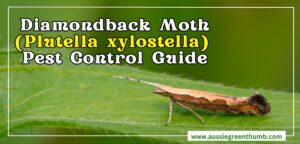Neem oil is one of the most useful natural chemicals you can use in the garden. Not only is it organic, but neem oil is also an incredibly potent pest repellent, insecticide, and fungicide, which will help to control outbreaks of pests and disease on garden plants and houseplants alike.
While it might seem like a silver bullet for all your garden problems, it’s still worth getting to know the facts about neem oil, the potential harms, and how to avoid them, as well as how to prepare it in different forms and formulas for each and every use. And that’s where I come in!
Follow our all-facts, zero-fluff guide for everything you need to know about neem oil.
More...
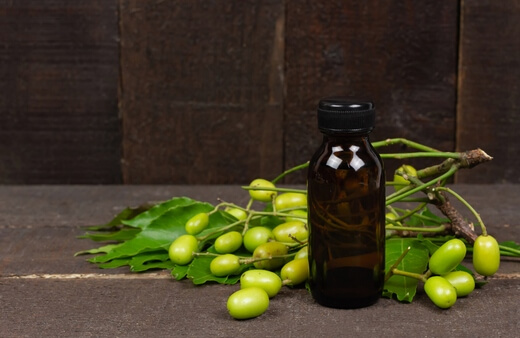
Neem Oil Product Ratings
Product | Our Rating | Price | |
|---|---|---|---|
1. Plant Needs Emulsified Neem Oil | 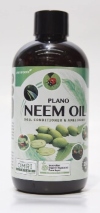 | ||
2. Plant Needs Grow N Save 100% Neem Cake |  | ||
3. The Plant Runner Neem Oil Natural Leaf Shine | 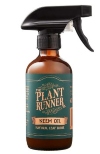 |
What is Neem Oil?
Neem oil is extracted from the oil-rich seeds of the neem tree (Azadirachta indica). The trees, native to India, are naturally insect repellent and put out such strong oils through their leaves and branches that they are virtually pest free, apart from a few very hardy species of soft scale insects (similar to mealybugs).
The oil extracted from the seeds of the neem tree contains huge concentrations of the chemical Azadirachtin, which is toxic in both ingestion and contact with most insect species.
Thankfully though, once the oil has dried on your plant, it is a deterrent rather than a killer, and will only kill insects that actively ingest it (so not bees, wasps, ladybugs, or worms).
How is Neem Oil Harvested?
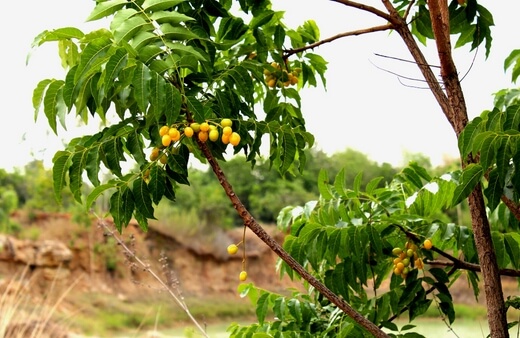
The seeds of the neem tree are often found to contain 50% pure neem oil, so when pressed, the oil extracted leaves behind just 50% of the original weight in dried seed. The leftover seeds are often crushed for a soil application that discourages pests without harming them too.
Once pressed, usually mechanically at room temperature, the oil is simply bottled, and ready to use. In some insecticidal soaps though, you will find concentrated neem oil, rather than raw neem oil, which is more potent, and easier to mix with other ingredients. It has the same effect.
What is Neem Oil Used For?
Neem oil has three main uses:
- Fungicide
- Pesticide
- Pest prevention
Pest prevention is perhaps the easiest route to success, as it requires dried neem granules, powder, or products called neem cakes, which treat the soil and imbue plants with low levels of Azadirachtin – not enough to kill pests, but enough to warn them off.
As a pesticide, the oil works in a few different ways; first, by coating the insects, they suffocate (simple); second, by shutting down their nervous system in reaction to Azadirachtin; and third, by dehydrating pests, and funguses, preventing them from spreading, and stopping eggs from hatching.
Keep reading for more information on the best ways to get the benefits of prevention, fungicidal use, or using neem oil as a pesticide.
How to Use Neem Oil
Depending on where, and more importantly when, you use neem oil, it will have different benefits and pitfalls. And, as we said earlier, any insect that is directly touched with wet neem oil is at risk of death. That included bees and butterflies, so think before you spray.
Using Neem Oil Indoors
Using neem oil indoors is simple, remember that your home is your oasis, but nature’s desert. That means that there are essentially no beneficial insects for houseplants as they don’t need pollinating, and aren’t typically used for food.


Get Your Free Guide:
Master Growing Australian Natives eBook
A Must Have Complete Guide for Every Australian Garden
Get Your Free Guide:
Master Growing Australian Natives eBook
A Must Have Complete Guide for Every Australian Garden
So yes, you can use neem oil at any time indoors, just be sure to close the door to the room for an hour after applying wet neem products to stop pets and young children from getting in and accidentally ingesting any.
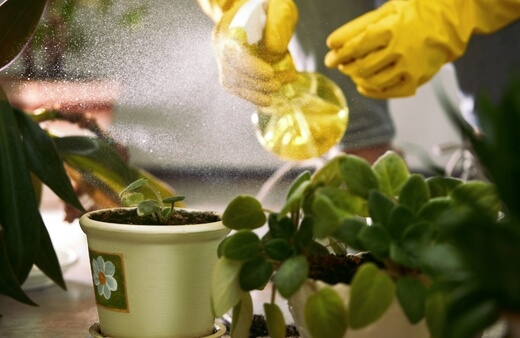
How to Use Neem Oil Outdoors
Using neem oil outdoors comes with a touch more responsibility. Understanding the active times of beneficial insects is a useful tool in planning when to use any pesticide, especially organic ones like neem oil that have a brief kill window.
Bees and wasps are more active in the early afternoon, and pretty much completely dormant once it goes dark outside. Butterflies are the same, but some species are particularly active at night when they can hide from birds.
Most species of moth are nighttime feeders, searching for evening-scented plants. So, if you’re going to spray neem oil outdoors, do it in the morning, ideally at sunrise. The moths will have gone to sleep, and the other beneficial insects are mostly still asleep for a few hours.
Check your plants for signs of beneficial insects, and target your spray as infected areas, or infestations.
Mixing Neem Oil for Different Uses
I’ll assume for now that you’re using wet neem oil, because it’s the most common preparation, and powders and cakes tend to be used simply by sprinkling onto the soil for preventative use.
And before I go into detail about how to prepare (and use) neem oil as a fungicide, pesticide, and preventative spray, it’s worth noting that the concentration will vary depending on exactly what you are treating.
In nearly all cases, I use two caps (20ml) to 500ml of water, but it’s still worth getting to know more thorough preparations.
How to mix neem oil as a fungicide
Neem oil is an excellent fungicide, but it will not prevent fungus infection, only cure it. By dehydrating and suffocating the fungal spores on the leaves, stems, and even roots of plants, neem is incredibly efficient in stopping fungal problems like blight, mildew, and root rot.
Using it in advance of infection may prevent it due to discouraging plant damage caused by insects, but it won’t stop fungal spores from landing and spreading without reapplication.
To kill fungal infections in their tracks, mix 20-30ml of neem oil with 450ml of lukewarm water, and grate in a small amount of soap (or a squeeze of organic hand soap) to help it stick to the foliage.
Treat both indoor and outdoor plants in the morning, so they don’t get burned with the afternoon sun, and don’t over-humidify in the evening.
Mixing neem oil as a pest prevention
As a preventative, you can either apply neem oil directly to the soil, to imbue plants with low levels of the chemical toxins (disrupting feeding cycles, and discouraging pests), or spray directly on the foliage in low concentrations.
Do not mix any soap into your neem oil mixture as this will create a film on foliage that prevents photosynthesis, and increase humidity to the detriment of your plants. Instead, mix 10-20 ml of neem oil with 450-500ml of cold water and shake it up really well before each spray to stop the oil from settling on the surface.
Treat outdoor plants in the morning to avoid accidental harm to wildlife, and treat indoor plants at any time.
Mixing neem oil as a pesticide
The most common way to use neem oil is as a direct pesticide. This works in a few different ways, but the easiest is to mix up 20 ml of neem oil with about 500 ml of lukewarm water, with a squirt of some organic liquid soap to improve its adhesion.
Treat any infestations thoroughly, and spray it directly onto any mealybugs, aphids, spider mites or thrips you see on your plants. Perhaps even more importantly, check the undersides of the leaves, and spray any with signs of leaf damage, eggs, or larva.
This medium-concentration of neem oil will disrupt the breeding and life cycle of pests, particularly on indoor plants, and can often be done just once a year, but is safe to repeat any time you notice a problem.
Now, for really extreme infestations, particularly of mealybugs, a direct attack is the best solution. When faced with an extreme infestation on any plant I use 100% cold-pressed neem oil, and paint it over clusters of bugs.
They die almost instantly, and any eggs they are protecting will die too. After half an hour, wipe away the bugs, and rinse the plant to protect it from the high concentrations of Azadirachtin which can potentially burn more delicate foliage.
Buyer’s Guide to Neem Oil
What to Look for When Buying Neem Oil
Organic, cold-pressed, pure neem oil is really the only thing you should be looking for on the label of any neem oil product. Pre-mixed neem oil is much more expensive, and is essentially just soap, water, and neem pre-mixed, while anything inorganic begs the question; what else is in there?
Remember, neem oil is an organic, naturally occurring product, so any neem oil that doesn’t have organic in big letters on the front probably has some pretty nasty stuff hiding in its ingredients list!
Because neem oil is so strong by itself, there’s nothing extra you need to add to kill most pests or prevent them. So choose the purest neem oil you can find, and afford, and use it sparingly.
Different Types of Neem Oil
Despite being a pretty straightforward, naturally occurring product, there are actually quite a few different forms you can buy neem oil in, from oils to soaps, to powders. Let’s take a look at some of the best types of neem oil to buy.
Cold pressed neem oil
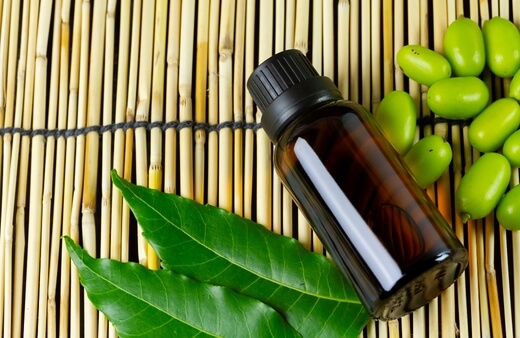
Cold pressed neem oil is the most common form of neem oil online and in garden centres. It is literally just pure neem oil, extracted from the seeds through pressure, and bottled. It will generally have some sediment at the bottom of the bottle, which can put some gardeners off, but I take it as a sign of a truly organic product.
Look for 100% cold pressure, or pure neem oil where possible so you know there’s nothing else luring in the bottle.
Neem cakes
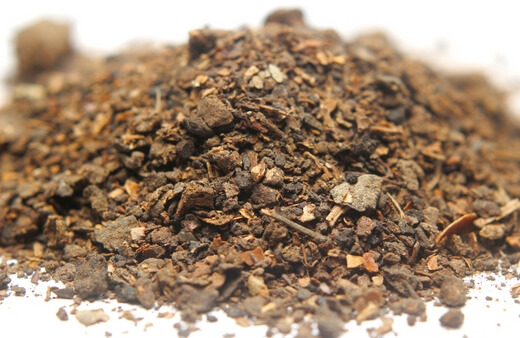
Neem cake is surprisingly useful as a soil treatment and doubles up as a fertiliser. It’s particularly good for overwintering houseplants, with eggs and larvae potentially hiding beneath the surface, waiting for new growth in spring.
When you give any deciduous, winter-dormant plant its final water of the season, just sprinkle neem cake on the soil, and water over it. Over time, the cake will filter down, and damage the development of eggs in the soil.
The same method works in the garden and is safe for worms and wildlife too. Outdoors, neem cake tends to work faster, but that also means they can distribute faster, so may need reapplying in late winter.
Neem Oil Safety Tips
Obviously, despite being organic and naturally occurring, neem oil is toxic. So never ingest it, and wash it out of your eyes, nose, and from your skin if the bottle should ever spill. Keep neem oil away from children and pets in a sealed cupboard, out of reach.
Best Organic Neem Oil Brands for 2025
1. Plant Needs Emulsified Neem Oil
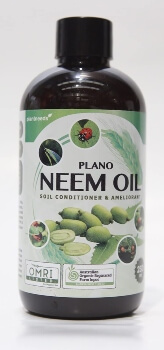
Plant Needs Emulsified Neem Oil
Emulsified cold pressed neem oil has all the benefits of basic neem oil, with the added bonus of mixing better in water, and adhering better to foliage. The process is easy enough to do at home, but it’s simpler to just buy pre-emulsified neem oil ready to use.
My go-to is Plant Needs’ neem oil, which lasts for several years if stored correctly.
The only downside of emulsified neem oil is that it costs slightly more, but it’s worth it to save on the complications of mixing non-emulsified oils with water and soap or having to emulsify your own.
Pros
Cons
2. Plant Needs Grow N Save 100% Neem Cake

Plant Needs Grow N Save 100% Neem Cake
Neem cake can be pretty expensive, but once in a while, you’ll find a good honest retailer who accepts it for what it is; a by-product. Plant Needs make one of the most widely used neem oils on the market, and offer the waste material as fertiliser online and in garden centres at about half the price of most brands.
Keep in mind that neem cake is more effective as a deterrent, and has mild nutritional benefits, so shouldn’t replace other feeds or compost.
Pros
Cons
3. The Plant Runner Neem Oil Natural Leaf Shine
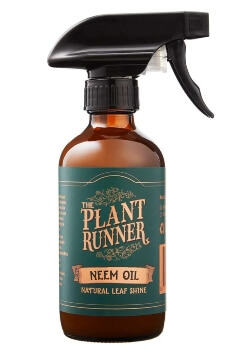
The Plant Runner Neem Oil Natural Leaf Shine
Neem oil might not seem like the most inspired gift in the world, but if you’re looking for genuinely thoughtful gifts for gardeners, this luxury, branded neem oil from The Plant Runner would definitely go down well.
The packaging is just gorgeous, and the glass bottles are completely recyclable, with refills available online to add to the appeal. This ready-to-use neem spray is made from a mix of cold pressed neem oil, and vegetable-based wetting agents so is completely organic, and ready to use.
Obviously, ready-mixed products are less cost-effective, but if you’re buying as a gift, sometimes the package really is everything.
Pros
Cons
Neem Oil Frequently Asked Questions
Is neem oil safe for pets and children?
Neem oil is organic, natural, and free from chemicals, but that doesn’t necessarily make it safe around pets. The oil acts as a nerve blocker, and a surfactant, so can shut down brain function, and organs and suffocate anything that ingests it.
The chances of a dog or cat ingesting neem oil are low, thanks to its pretty repulsive scent, and if they do, they would need to ingest a large amount, but it’s still worth treating plants, and leave rooms locked for an hour after use so the oils can dry.
If you spill neem oil on your hands and suffer from any skin condition or allergies, rinse it immediately with soap and water as it can cause severe rashes.
Is neem oil the same as Castile soap?
Castile soap and neem oil have similar applications, and I quite like to mix them up in the same spray bottle. Castile soap is an insecticide in itself, and naturally occurring, which helps treat pest infestations and fungal problems at the same time.
Does neem oil kill bees?
Neem oil kills bees and any other insect it comes into direct contact with while wet. To avoid harming wildlife, use neem oil in the morning when bees, butterflies, and moths are less active, and allow it to dry after application. Once dry, neem oil is much less effective at killing and becomes a deterrent.
Does neem oil kill aphids?
Neem oil is the most effective natural aphid remedy for all plants. Not only does neem oil kill aphids, but it has long-term preventative properties as aphids will not congregate on a plant if they sense the active chemical, Azadirachtin.
Does neem oil prevent fungus?
Neem oil will not prevent fungal infection, but it will kill it. funguses are living organisms, and fungal infections on plants are a connected network of living microorganisms, so using neem oil will not stop it from landing on or infecting a plant, but it will suffocate it and dry it out once it's there.
Wrapping Up Our Neem Oil Guide
Neem oil is my go-to pest treatment on pretty much all my plants, but I do tend to use it indoors rather than outdoors. With crops and outdoor plants, it’s always best to take a more hands-on approach if you can.
To support a truly organic garden, encourage more wildlife in. The more wasps, ladybugs, and natural pest predators you have, the fewer pests you’ll need to control. However, that’s perhaps more of a dream than a reality for most Australian gardeners.
Just stick to this guide for using neem oil and you should have many years of happy gardening, with minimal pest problems as a result.
Published on November 21, 2022 by Gary Clarke
Last Updated on December 27, 2025



